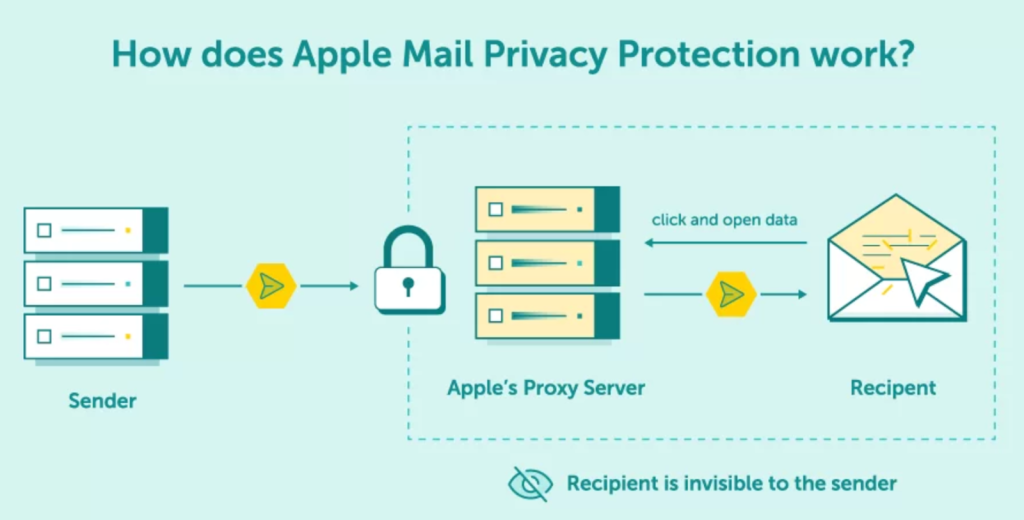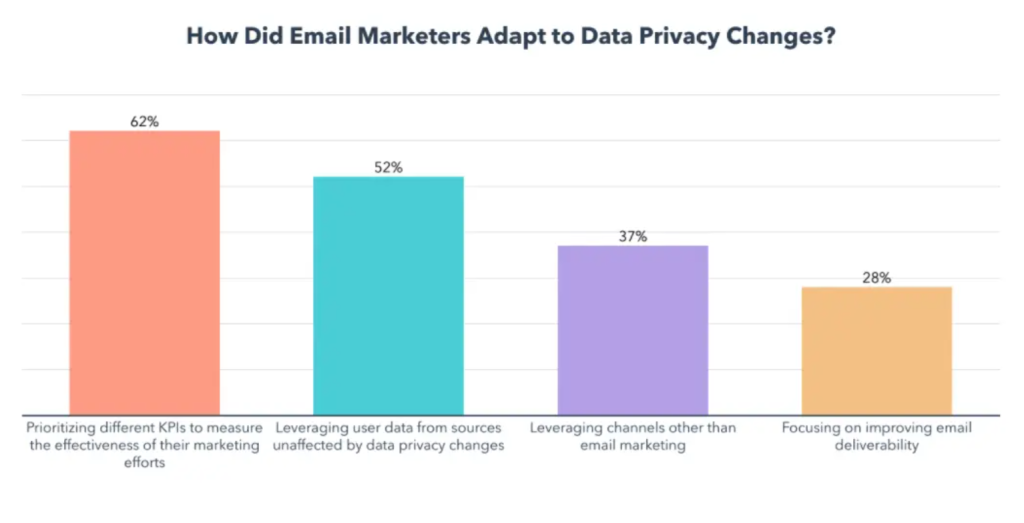- Home
- Fundamentals of Email Marketing
- Apple MPP: What It Means for E ...

In recent years, there’s been growing attention on protecting users’ privacy and personal data. For consumers, this is undoubtedly a good thing. People now have more control over how their information is collected, shared, and stored. But there’s another side to the story: the more privacy is protected, the less feedback marketers can gather from their campaigns. Metrics that once felt reliable suddenly become blurred. And one of the biggest changes in this area came with Apple MPP—a feature that quickly raised the question of what MPP is and what it means for the future of email marketing.
So, is this shift really as bad as it sounds? Or is it simply a push for marketers to move past outdated metrics and explore smarter, more sustainable ways of collecting data? In this article, we’ll explore what Apple MPP is, what it means for email marketing, and how businesses can adapt to these new rules of the game.
What Is Apple MPP?
If you’ve been following email marketing trends over the past few years, you’ve probably heard the term “Apple MPP.” If you don’t know what MPP stands for—it stands for Mail Privacy Protection, a feature Apple introduced in 2021 to give users more control over their email data.
It’s designed to limit the amount of information email senders can collect about their recipients. Instead of allowing marketers to see when, where, and how an email was opened, Apple Mail decided to provide an option to blur those signals.
Here’s a simplified explanation of how it works in practice:
👉 Apple preloads email content on its own servers. This makes it look like every email has been opened, even if the user never actually read it.
👉 It also masks IP addresses, which means you can’t track a subscriber’s location or device the way you could before.
The key thing to note is that Apple Mail Privacy Protection applies to any message opened inside the Apple Mail app. It does not matter whether the inbox itself is Gmail, Outlook, Yahoo, or something else. As long as the reader uses Apple Mail on iOS, iPadOS, or macOS, Apple MPP is in effect.
For email marketers, this reasonably new feature had major implications, since metrics like open rates, location tracking, and device data suddenly became unreliable. That means that strategies had to adapt as well. To know how—read further.
Why Apple Introduced MPP
💎 Growing consumer demand for privacy
Over the last decade, people have become far more aware of how much of their data is being tracked and shared. From cookies to app tracking, consumers are no longer comfortable with the idea of companies collecting information without consent. So, features like email encryption and data masking have become part of a larger conversation about giving users more control over what happens to their personal information. Apple MPP appeared as a response to this trend and reflects the growing demand for stronger privacy protections in digital communication.
💎 Apple’s positioning as a privacy-first brand
Privacy has become one of Apple’s strongest selling points. Apple has consistently promoted itself as the company that protects user data, from limiting cross-app tracking to blocking third-party cookies in Safari. The same philosophy extends to email protocols, where Apple has taken steps to minimize how much information senders can gather through tracking. By launching Apple Mail Privacy Protection, the company reinforced its image as the tech brand most committed to user privacy.
💎 How MPP aligns with the GDPR, CCPA, and other privacy regulations
While Apple MPP is not itself a legal requirement, it fits into the global movement toward stricter privacy standards just right. Regulations such as the EU’s GDPR and California’s CCPA put user rights at the center of digital interactions. By masking IP addresses and preloading email content, Apple Mail Privacy Protection helps Apple align with the core idea of these regulations—by offering users more transparency and control over how their information is used.

How Apple MPP Impacts Email Marketing
When Apple first introduced Apple MPP, it caused quite a concern among marketers. And there’s no surprise—the feature directly changed the way core metrics were tracked, leaving many of the traditional tools and assumptions less reliable than before. Here are the key areas where the impact of Apple Mail Privacy Protection on email marketing is most visible:
⚠️ Unreliable open rates
For years, open rates were the go-to metric for measuring subject line performance and campaign engagement. With Apple Mail Privacy Protection preloading content on its servers, every email can appear “opened,” regardless of whether the recipient actually read it or not. That makes it impossible to distinguish genuine engagement from automated preloads. It also means that marketers can no longer trust open rates as a reliable measure of success.
⚠️ Lost location data
Because Apple MPP masks IP addresses, geo-based targeting has largely disappeared. You can’t tell whether a subscriber is opening an email from Paris or New York, which means strategies like location-specific promotions or event-based campaigns are harder to execute. The kind of precise personalization that relied on location signals simply doesn’t work anymore.
⚠️ Reduced behavioral triggers
Many marketing automations were built around the open event—sending a follow-up email to those who opened or triggering a reminder for those who didn’t. With MPP inflating opens, these behavioral triggers break down. A subscriber might look like they engaged when in reality they didn’t, which makes automation flows less effective and sometimes even misleading.
⚠️ Broader effects on segmentation, deliverability, and testing
When one foundational metric (opens) is no longer accurate, it impacts the rest of the system. Segmentation becomes less precise, since you can’t cleanly separate active from inactive subscribers. Deliverability strategies that relied on opens as a health signal also suffer, because inbox providers can’t distinguish highly engaged users from silent ones. Even testing becomes trickier, since open rate data is distorted and harder to interpret.

Adapting to the New Reality
While the appearance of Apple MPP might seem like the beginning of an end for email marketing, in fact, it only means that the rules of the game have changed. As opens are no longer the reliable signal they once were, marketers need to look elsewhere for truth and adjust their strategies accordingly. Here are some of the most effective ways to do that:
✅ Rethink subject line testing
With open rates now blurred by Apple MPP, marketers can no longer depend on them to judge performance. It means that opens need to be replaced with something else as a measure of success, such as clicks. Since clicks reflect actual engagement, subject line tests should instead be based on them. This way, subject line A/B testing becomes more accurate and meaningful.
✅ Focus on zero-party data
As passive signals like opens and location disappear, the value of zero-party data grows. What is zero-party data? This is information subscribers willingly share about their preferences, needs, and intentions. By asking directly, brands can replace guesswork with insights that lead to more accurate and trusted communication.
✅ Use engagement surveys, preference centers, and polls
Surveys, polls, and preference centers provide simple but effective ways to capture zero-party data. They let subscribers define how often they want to hear from you, which topics they care about, and what formats they prefer.
✅ Prioritize deliverability best practices
Without reliable open data, the importance of a healthy email list matters even more than before. When you regularly clean your email lists and use double opt-in, you make sure that emails reach inboxes. These steps also signal to providers that your audience genuinely wants your messages, which is a positive thing for deliverability.
✅ Consider multi-channel engagement
Email remains central, but they don’t have to be the only ones. By adding other channels, such as SMS, push notifications, or social media, marketers can create additional touchpoints with subscribers. This diversifies communication, reduces reliance on a single channel, and keeps engagement strong, even when rules are changing.
Best Practices for MPP-Era Email Marketing
The changes brought up by Apple MPP made some previously effective tactics less reliable, but at the same time, this encouraged marketers to focus on other engagement strategies that can be measured. Here are the practices that work best with MPP:
💎 Craft compelling CTAs to drive clicks
Without opens being a reliable metric for engagement measurement, clicks took this prime spot for assessing how customers interact with emails. This puts even more value and importance on CTAs because a strong CTA not only guides a reader towards the next step but also becomes the key to getting realistic engagement data. The better your CTA is, the more likely it will be clicked—and the more likely you will have an accurate measurement of your results.
💎 Segment based on clicks and purchases rather than opens
Today, grouping subscribers by clicks, website activity, or purchase history creates a more accurate picture of who is really engaged. Unlike opens, these signals can’t be distorted by privacy protection, which makes them a solid foundation for targeting and personalization.
💎 Build stronger relationships with subscribers through personalization
The more personalized your emails are, the higher the chances that people will click once they’ve opened. Make your emails adjusted to preferences, behaviors, and past interactions. This not only increases the chance of engagement with a single email but also helps build long-term relationships.
💎 Create value-driven content so subscribers want to engage
No amount of optimization can replace genuine value. Whatever your content is, emails should feel worth opening and provide people with something meaningful. With or without MPP, subscribers engage not because they are tracked, but because the content itself is worth reading.
To Sum Up
Users’ privacy and personal data protection are here to stay—there is no doubt about that. Not only that, but they’re going to get increasingly stricter.
So, Apple MPP is only one of the first company attempts to tune into the overall trend of privacy and data protection. Considering that it’s been with us for four years, it seems to be quite successful.
Another question is: what MPP brings with it outside of data privacy for dimensions such as email marketing. That we are still figuring out. From what we can see so far, and what we tried to show in this article, email marketing can successfully evolve alongside all the new rules. And that is yet another thing for email marketers to celebrate.



